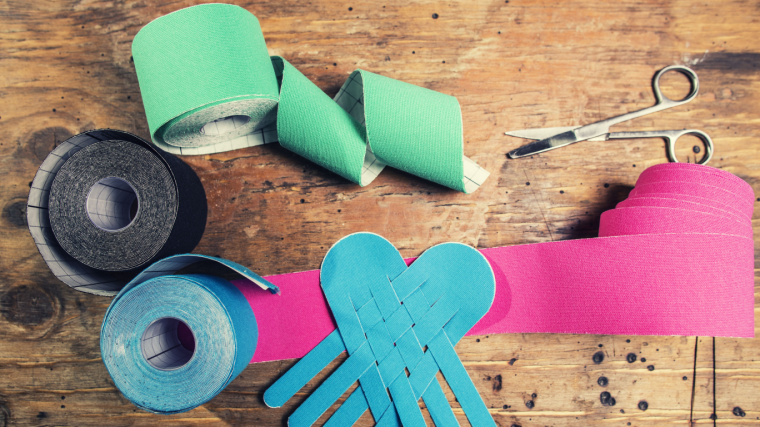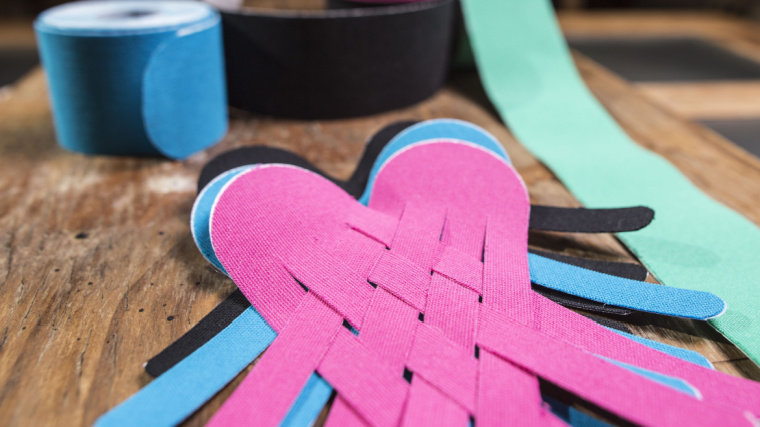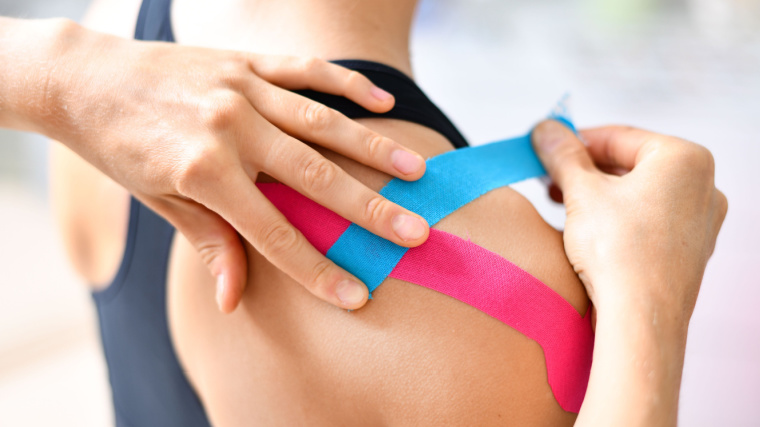You’ve probably seen it at your local gym or if you happened to catch part of an event like the CrossFit Games on television: Athletes strutting around looking like Amazon packages, bound up in black tape.
No, it’s not a gift-wrapping session gone horribly wrong. It’s kinesiology tape, a sports medicine practice that has gained quite a lot of momentum in recent years among recreational and pro athletes alike.

But the question is, does kinesiology tape work? If so, how exactly? It may feel like a bit of a stretch to assume that taping a joint can help it heal faster, prevent future injury, or enhance performance. Let’s dig into the science and consult an industry expert to find out for sure whether kinesiology tape really works.
- What Is Kinesiology Tape?
- Potential Benefits of Kinesiology Tape
- Does Kinesiology Tape Work?
- How to Use Kinesiology Tape
- Frequently Asked Questions
Editor’s Note: The content on BarBend is meant to be informative in nature, but it should not be taken as medical advice. When starting a new training regimen and/or diet, it is always a good idea to consult with a trusted medical professional. We are not a medical resource. The opinions and articles on this site are not intended for use as diagnosis, prevention, and/or treatment of health problems. They are not substitutes for consulting a qualified medical professional.
What Is Kinesiology Tape?
Though it has gained a lot of momentum in recent years, the history of kinesiology tape goes back decades. It was originally developed in the 1970s by Dr. Kenso Kase and has been sporadically utilized in sports rehab settings since its creation. (1)

[Read More: Kinesiology Taping for Posture]
Kinesiology tape — colloquially known as KT tape — is a cotton-based tape with a strong adhesive surface meant to stick tightly to the skin and provide tactile feedback to the athlete while they exercise.
How Kinesiology Tape Works
First things first, the basics: kino tape is usually applied as a physical procedure by a physical therapist or sports medicine professional. Tape is adhered directly across a joint or site of acute soft tissue injury and is considered a form of physical “body work,” says Dr. “Bo” Babenko, a practicing Doctor of Physical Therapy and online personal trainer.
[Read More: Kinesiology Taping for Ankle Stability and Sprain]
A comprehensive survey of over one thousand participants published in the International Journal of Sports Physical Therapy outlined the main purposes of kinesiology tape in the eyes of clinicians. (1) According to the survey, most practitioners use “kino tape” for:
- Post-injury treatment
- Pain modulation
- Neurosensory feedback
These three primary use cases are linked; “neurosensory feedback” refers to the sensation the tape provides on the skin, which can help an athlete be more aware of their posture and potentially avoid painful ranges of motion. This can help the wearer avoid painful sensations or re-aggravating an injury they’re currently working through.
Potential Benefits of Kinesiology Tape
KT tape is undoubtedly a popular recovery modality among athletes. That said, the scientific evidence studying it isn’t universally compelling. Regardless, you may stand to benefit from kinesiology tape in the following ways:
It May Improve Proprioception
“Proprioception” describes your ability to sense your own body’s position in space — think knowing exactly where your arm is during a movement like the Turkish get-up, even if you aren’t looking at it.
[Read More: Kinesiology Taping for Hip Pain]
Better sensory sensitivity is one of the main purported perks of KT tape. The tape is applied very snugly to the skin and will pull or tug if you move that part of your body too aggressively or abruptly. This can provide you with some real-time feedback about your exercise technique and movement habits so you can make adjustments on the fly and steer clear of any postures that may be painful.
KT Tape Might Supplement Other Rehab Techniques
Most scientific papers studying kinesiology tape have examined its efficacy alongside other common physical therapy practices. The general assertion thus far is that taping can be a useful aspect of a comprehensive rehab plan, but isn’t especially effective on its own merit.
However, this shouldn’t be discouraging for you if you’re interested in trying KT tape. You’d be hard-pressed to find a practicing clinician who is willing to tape you without also performing other types of therapy relief. At worst, kinesiology tape isn’t likely to worsen any pre-existing injury or condition.

[Read More: Kinesiology Taping for Tennis Elbow]
Dr. Babenko emphasizes that taping is, literally, a band-aid fix to some of the issues that may arise when working through an injury: “Taping is a tool to help get you through one or two lifting sessions, but should not be relied on for multiple weeks or months.”
Provides Psychological Support
Dr. Babenko reports that he’s seen some tremendous improvement in the mind state of his clients by incorporating kinesiology tape. “It seems to provide a strong psychological benefit. It’s a tool I use any time someone wants to keep moving [while injured],” he says, emphasizing the importance of positive perspectives on injury rehab.
[Read More: Kinesiology Taping for Lower Back Pain and Stability]
The mental confidence afforded by kino tape aligns with empirical findings, too. KT tape may be considered a placebo from a physiological standpoint, but science supports the idea that believing in your treatment can actually cause you to heal faster. (2)
Does Kinesiology Tape Work?
Kinesiology tape is commonly used in physical therapy clinics, sports medicine settings, and even triage situations during athletic events. Dr. Babenko remarks that he noticed taping really took off in the mid-2010s: “I am surprised on the rare occasion where folks in my practice, who are highly active, have never tried the tape. It’s such a nice tool to have in the grand scheme of rehabilitation.”
[Read More: Kinesiology Taping for IT Band]
But despite a relatively recent surge in popularity, the existing body of scientific evidence surrounding kinesiology tape is inconsistent at best.
- A 2014 systematic review & meta-analysis summarized its findings by stating that, “kinesiology tape may have limited potential to reduce pain … depending on the conditions, the reduction in pain may not be clinically meaningful.” (3)
- However, other studies have displayed “weak to moderate” evidence in favor of KT tape for assisting with conditions like lymphedema or shoulder impingement. (4)(5)
Little data exists that strongly supports the efficacy of kinesiology tape as a standalone method of injury rehabilitation or pain management.
That said, most studies acknowledge that KT tape can be a valuable aspect of physical therapy treatment when applied in conjunction with other, more substantive treatment protocols.
How To Use Kinesiology Tape
Whether you’re a professional powerlifter, a full-time collegiate athlete, or are just looking to relieve some nagging aches and pains from time to time, you might have a use case for kinesiology tape.
However, it’s not as simple as wrapping a Christmas present. There’s a technique to it — most of the time, taping is done as a service by a clinician with experience. Dr. Babenko notes that tape companies tend to be inconsistent with their directions on how and where to best apply KT tape, and that there’s certainly an element of trial and error at play.
[Read More: Kinesiology Taping for Knee Pain and Stability]
Depending on the location and nature of your injury, you can tape yourself if you’re in a bind. Here’s how to properly apply KT tape:
- Step 1 — Clean and dry the area of skin you intend to apply tape to.
- Step 2 — Cut the tape and remove the backing that protects the adhesive side. Cut a bit less tape than the area you’re applying it to in order to maintain tension.
- Step 3 — Apply the “anchor end” of the tape and then press the remainder down against the skin.
- Step 4 — Gently press along the length of the tape to remove any air gaps and seal it against the surface of the skin.
Note that there are also different styles and cuts of KT tape. The three primary cuts are the “I-cut”, “Y-cut”, and “fan cut”. Each is cut differently to be easily applied to various regions of the body; for instance, the fan cut is often applied to the plantar fascia along the underside of the foot.
You can also shower or bathe while wearing adhesive tape. Just remember to gently pat the area dry afterwards and to not drag a towel or cloth perpendicular to the direction the tape is laid on your skin.
Your Takeaways
While kinesiology tape may have some benefits in certain contexts, it doesn’t have a substantive body of evidence supporting it as a useful technique in its own right, despite years of popularity among athletes and clinicians.
Regardless, practicing physical therapists like Dr. Babenko make regular use of kino tape on patients of all backgrounds and athletic levels. “More education about taping techniques is needed, since it has some great applications and I’ve seen success with it when applied in the right contexts.”
- Kinesiology tape, also known as KT tape or kino tape, is a physical adhesive tape applied to sites of sporting-related injury or discomfort.
- KT tape provides neurosensory feedback to the wearer about the position of a given joint or the action of a muscle.
- Some evidence has shown that kinesiology tape can be beneficial alongside other physical therapy practices.
- Most available data indicate that KT tape does not provide substantial relief on its own, but may help improve certain conditions in a limited capacity.
FAQs
Still wondering if kinesiology tape is right for you? Check out these common questions.
How long does it take kinesiology tape to work?
Once applied, kinesiology tape should provide some immediate relief, depending on the nature of the injury. You can apply KT tape as necessary and proceed with your workout afterward.
How long should you wear kinesiology tape?
Try to wear KT tape as little as possible — you don’t want to rely on it full-time. That said, there’s no harm in leaving it on for multiple hours if you’re going to be performing strenuous activity or an extended workout.
What are the benefits of kinesiology tape?
Studies have shown mixed results, but kinesiology tape can potentially reduce some perception of pain at the site of an injury. Athletes also rely on it for kinesthetic feedback while they work out, as the tape can help remind you to avoid problematic ranges of motion.
Can you apply kinesiology tape yourself?
You can, depending on the site of your injury. However, proper application techniques are intricate and tape should be applied by a qualified clinician or physical therapist when possible.
References
- Cheatham SW, Baker RT, Abdenour TE. Kinesiology Tape: A Descriptive Survey of Healthcare Professionals in the United States. Int J Sports Phys Ther. 2021 Jun 1;16(3):778-796. doi: 10.26603/001c.22136. PMID: 34123530; PMCID: PMC8169012.
- Rossettini, G., Carlino, E., & Testa, M. (2018). Clinical relevance of contextual factors as triggers of placebo and nocebo effects in musculoskeletal pain. BMC musculoskeletal disorders, 19(1), 27.
- Montalvo, A. M., Cara, E. L., & Myer, G. D. (2014). Effect of kinesiology taping on pain in individuals with musculoskeletal injuries: systematic review and meta-analysis. The Physician and sportsmedicine, 42(2), 48–57.
- Ismail Saracoglu , Yusuf Emuk & Ferruh Taspinar (2018) Does taping in addition to physiotherapy improve the outcomes in subacromial impingement syndrome? A systematic review, Physiotherapy Theory and Practice, 34:4, 251-263
- Karina Tamy Kasawara, Jéssica Monique Rossetti Mapa , Vilma Ferreira , Marco Aurélio Nemitalla Added , Silvia Regina Shiwa , Nelson Carvas Jr & Patricia Andrade Batista (2018) Effects of Kinesio Taping on breast cancer-related lymphedema: A meta-analysis in clinical trials, Physiotherapy Theory and Practice, 34:5, 337-345
Featured Image: Patricia Chumillas / Shutterstock